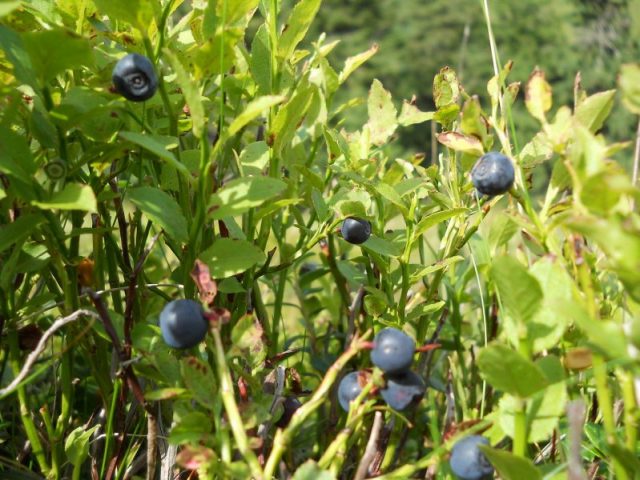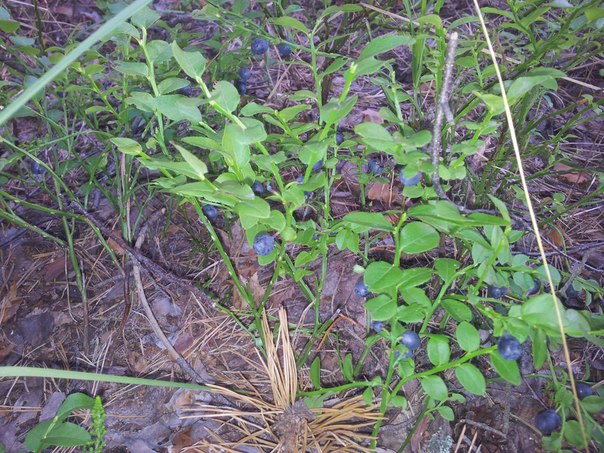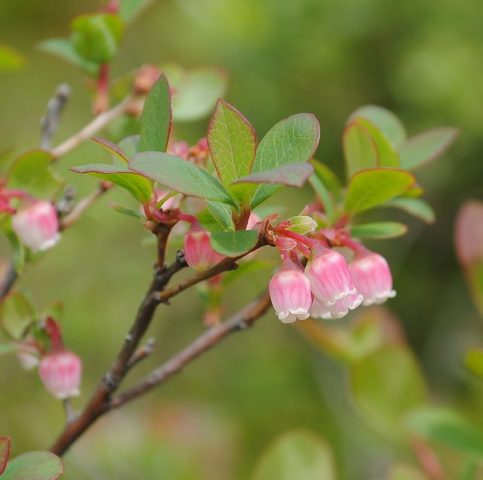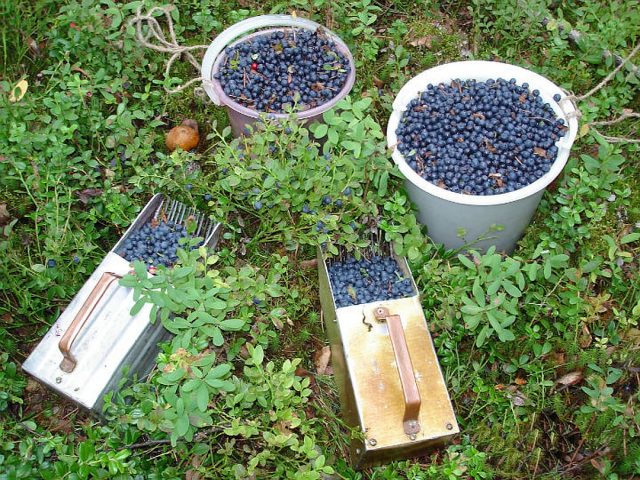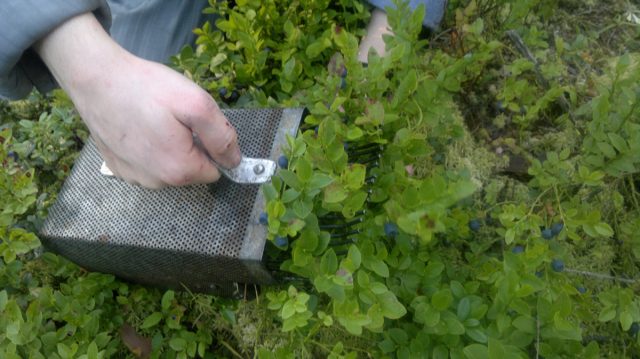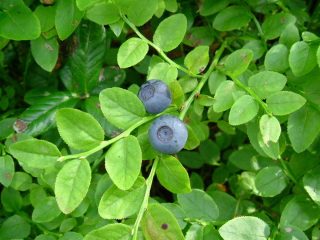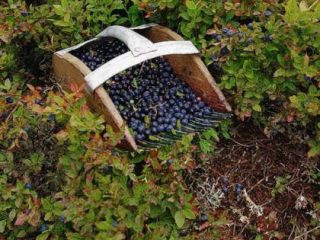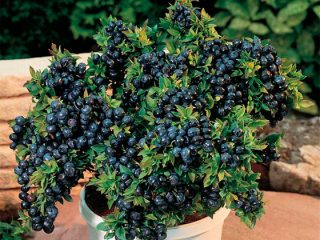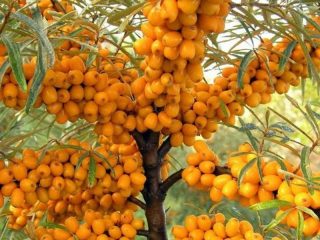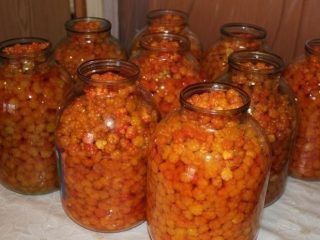Content
Lovers of fresh wild berries explore the blueberry sites and come there every summer. There are a lot of blueberries in the forests of Russia, and industrial harvesting of berries is organized. Unfortunately, the use of mechanical devices injures the bushes. Therefore, those who value an environmentally friendly attitude to nature collect medicinal berries for their own benefit and at the same time try to preserve the valuable flora of the forests.
What blueberries look like in the forest
Blueberries are recognized by their low bushes, up to 15-40 cm in height; they grow in areas rich in moisture and with high soil acidity. Creeping blueberry plants. Thin shoots are green or dark brown, flexible, sparsely leafy, usually at the tops of twigs. Ovate leaves are small, with a finely toothed edge, a sharp tip, 1-2 cm long, bright green, stand out well on brown forest ground. The berries are solitary, small, less than 1 cm in diameter, covered with a dark blue skin with a whitish bloom.
How blueberries grow in the forest
Usually blueberries in the forest, as seen in the photo, are easy to spot because of the light leaves. Bushes often grow crowded, one next to the other. Pine forests and dark spruce forests, located in cold and temperate climates, are rich in medicinal berries, although large blueberries are also found in mixed forests.
How many blueberries grow
The berry forest plant is distinguished by its life expectancy and fruiting. The bush develops over 40-41 years. The first berries appear on plants over 4 years old. The peak of fruiting occurs after the tenth year of development and lasts 5-7 years. Then the yield drops significantly. Although the bush grows branches, it increases in volume, but the fruits on it are less and less.
How blueberries bloom
Single drooping flowers in the shape of an elegant jug of pink-greenish color bloom from the last days of May to the end of the first decade of June. Flowering times vary slightly, depending on the weather in the region where the blueberry grows.
When blueberries ripen in the forest
The first blueberries are found in July, on those bushes that grow on the edges and are warmed by the sun. The mass gathering occurs in August, even lasts until mid-September. The fruits are small, weighing less than 1 g, resembling a dark blue ball. Their tops are slightly flattened, with pronounced concentric lines in the depression. The pulp is juicy, dark in color, which quickly stains the skin or fabric. The berries are sweet and sour to taste.
Where blueberries grow in Russia
In almost all northern regions and in regions of the temperate climatic zone, blueberries grow, choosing coniferous or mixed forests as their habitat. The area should be rich in moisture, even marshy, with a predominance of acidic soils. Many medicinal fruits are harvested in the south of the Arkhangelsk region, in Karelia, the Leningrad and Pskov forests, the Ural and Siberian taiga.
Where to pick blueberries in the Leningrad region
The Northwest region abounds in conditions in which blueberries grow and bear fruit successfully: wetlands and forests with a lot of conifers.In the Leningrad Region, medicinal berries grow everywhere. Blueberries are harvested both in the forests of its southern regions and northern ones. There is information that blueberries are especially abundant in the Vyborg region. Berry hunters boast that in the local forests it is easy to fill a liter container in an hour.
Where blueberries grow in the suburbs
Rich in blueberries and forests of the Moscow region:
- spruce forests along the swamps;
- mixed birch-spruce forests;
- birch forests.
Berries are harvested in the following areas:
- Dmitrovsky;
- Taldom;
- Orekhovo-Zuevsky;
- Shatursky;
- Egoryevsky;
- Sergiev Posad;
- Shchelkovsky;
- Mozhaisk.
There are berry places in Ruzsky, Naro-Fominsky, Lotoshinsky, Shakhovsky and other districts.
Where blueberries grow in the Nizhny Novgorod region
The left bank of the Volga in the Nizhny Novgorod region is famous for its coniferous forests of the southern taiga type. They often go to pick berries. According to reviews, blueberries grow well relatively close to the regional center - in Borsky district, as well as in Volodarsky, where there are many wetlands.
How to pick blueberries quickly
Small berries that grow alone take a long time to collect. You need to bend over to each bush and pick a berry. Lucky for those who find blueberry in the prime of its fruiting potential. And collection from old bushes is weak. It is necessary to take into account the places where the medicinal berry grows. The meadows near the roads have most likely been explored more than once. There are only the remnants of the current year's harvest. Whoever goes deep into the forest finds untouched blueberries.
Before the hike, be sure to think over the equipment: warm and waterproof clothing and shoes to protect yourself from ticks. Particular attention is paid to footwear. Forest blueberries grow in swampy areas where vipers also live. Therefore, the berries are collected very carefully, carefully examining the area. They also stock up on repellents from mosquitoes and midges. Residents of cities will benefit from using sunscreen.
An important element is a convenient container that allows picking berries with both hands:
- one that can be put on the ground - a plastic bucket, always with a handle, or baskets lined with paper or plastic bags;
- light containers of milk or kefir with strings threaded and tied to them, which are attached to the shoulders;
- small baby buckets, also complete with string to hang around the neck.
How to quickly pick blueberries with your hands
The berry pickers in the forests have developed a kind of set of requirements for effective work:
- among the bushes that grow in the meadow, they are looking for the most productive;
- pluck larger fruits, with black skin;
- very small, greenish-white do not tear, because blueberries ripen while they are growing, not ripening;
- tearing off the stem, the fruit is scrolled, and it is removed;
- unripe berries do not break easily, they are left, because they are tasteless;
- if there are a lot of fruits on the branch, they are all seized with the palm and lightly rubbed - ripe ones come off immediately.
Blueberry pickers
In places where valuable forest fruits grow en masse, pickers use special handheld harvesters. These devices are similar to a scoop equipped with long rake teeth from below. Stems with a large number of fruits are picked up by the combine and pulled. Together with the berries, a lot of herbs and leaves get into the container. Many berries are also damaged. Shoots are injured. Therefore, amateurs do not like this method. It is used only by those who earn in this way.
Harvesters of forest products make such devices themselves or purchase them on the market.Then from the collected leaves, fragments of branches and other weed inclusions are winnowed. There are vacuum harvesters for collecting small fruits. They are also used by brigades that hunt in distant forest plantations where there are many bushes.
Berry harvesting rules
It is difficult to pick enough small fruits, this is physical work, you will have to walk a lot and bend over to the plants. It is advisable to harvest medicinal products in the morning or in the afternoon, in the late afternoon. Fatigue will be less.
If blueberries grow in forests near industrial cities, it is better to refrain from picking in such places. Berries that grow along high-traffic tracks are also unfavorable.
When harvested by hand, the leather will definitely be in dark blueberry juice. For collecting, which is not a pity to stain with forest fruit juice, which is very difficult to remove. Approaching the plant, you can not deliberately crush the fallen overripe berry, which will also stain the soles of your shoes. Therefore, returning from the forest, they do not enter the house in boots.
We must also remember about safety, since bears love to feast on sweet fruits. Inexperienced and unfamiliar with the life of the forest, pickers should go in groups of several people.
An unspoken rule of etiquette is to leave a few fruits on the blueberry plant for other pickers.
Damaged berries are not thrown away, but ground with sugar or jam is made.
Conclusion
Having remembered the place where blueberries grow, amateurs come to pick the valuable berries the next year. Although the collection is not easy, once you get the hang of it, you can stock up on healing fruits for the family.
